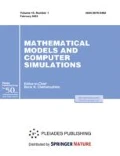Abstract
The generation of an electromagnetic field in a region with a perfectly conducting boundary by a long duration pulse of ionizing radiation is considered. The problem of calculating the field by numerically solving the complete system of Maxwell equations is posed. The approximations of the large and small radiation conductivity of the medium in the region are formulated. Analytical estimates of the solution of Maxwell’s equations are constructed for approximations in simplified formulations. By analyzing them, methods for calculating the electromagnetic field in a model based on the Maxwell equations in the full formulation are substantiated. An approach to modeling the field in the formulations that require an unacceptable number of computation for the stable solution of the Maxwell difference equations is proposed. The approach makes it possible to simulate the generation of an electromagnetic field by radiation from outer space in apparatus blocks using programs that solve Maxwell’s equations in a complete formulation.
Similar content being viewed by others
REFERENCES
G. D. Watkins, “A review of EPR studies in irradiated silicon,” in Radiation Damage in Semiconductors (Academic Press, New York, 1965), pp. 97–111.
L. D. Landau, E. M. Lifshitz, and L. P. Pitaevskii, Electrodynamics of Continuous Media, 2nd ed., Course of Theoretical Physics, Vol. 8 (Elsevier Butterworth–Heinemann, Oxford, 1984).
A. V. Berezin, A. A. Kriukov, and B. D. Plyushchenkov, “The method of electromagnetic field with the given wavefront calculation,” Mat. Model. 23 (3), 109–126 (2011).
I. B. Bakholdin, A. V. Berezin, A. A. Kryukov, M. B. Markov, B. D. Plyushchenkov, and D. N. Sadovnichii, “Electromagnetic waves in media with permittivity dispersion,” Math. Models Comput. Simul. 9 (2), 190–200 (2017).
A. V. Berezin, A. S. Vorontsov, S. V. Zakharov, M. B. Markov, and S. V. Parot’kin, “Modeling of prebreakdown stage of gaseous discharge,” Math. Models Comput. Simul. 5 (5), 492–500 (2013).
S. K. Godunov and V. S. Ryabenkii, Difference Schemes: An Introduction to the Underlying Theory, Studies in Mathematics and its Applications, Vol. 19 (North-Holland, Amsterdam, 1987).
J. P. Boris and D. L. Book, “Flux-corrected transport. I. SHASTA, a fluid transport algorithm that works,” J. Comput. Phys. 11 (1), 38–69 (1973); “II. Generalization of the method,” J. Comput. Phys. 18 (3), 248–283 (1975).
S. N. Vernov and A. E. Chudakov, “Terrestrial corpuscular and cosmic rays,” in Space Research, Ed. by H. Kallmann Bijl (North-Holland, Amsterdam, 1960), pp.751–796.
H. Davies, H. A. Bethe, and L. C. Maximon, “Theory of bremsstrahlung and pair production. II. Integral cross section for pair production,” Phys. Rev. 93 (4), 788–795 (1954).
L. D. Landau and E. M. Lifshitz, The Classical Theory of Fields, 4th ed., Course of Theoretical Physics, Vol. 2 (Elsevier Butterworth–Heinemann, Oxford, 1975).
W. Heitler, The Quantum Theory of Radiation (Clarendon Press, Oxford, 1954).
N. F. Mott and H. S. W. Massey, The Theory of Atomic Collisions (Clarendon Press, Oxford, 1965).
M. Gryziński. “Classical theory of electronic and ionic inelastic collisions,” Phys. Rev. 115 (2), 374–383 (1959).
Y.-K. Kim and M. E. Rudd, “Theory for ionization of molecules by electrons,” Comments At. Mol. Phys. 34 (3–6), 309–320 (1999).
M. B. Markov and S. V. Parot’kin, “Kinetic model of radiation-induced gas conductivity,” Math. Models Comput. Simul. 3 (6), 712–722 (2011).
D. N. Sadovnichii, A. P. Tyutnev, S. A. Khatipov, and Yu. A. Militsin, “Radiation electrical conductivity of rubbers and a method of its prediction,” Khim. Vys. Energ. 32 (1), 7–13 (1998).
A. S. Il’inskii, V. V. Kravtsov, and A. G. Sveshnikov, Mathematical Models of Electrodynamics (Vyssh. Shkola, Moscow, 1991) [in Russian].
A. N. Tikhonov and A.A. Samarskii, Equations of Mathematical Physics (Nauka, Moscow, 1977; Dover, NewYork, 1990).
A. Erdélyi, Asymptotic expansions (Dover, NewYork, 1956).
Author information
Authors and Affiliations
Corresponding authors
Rights and permissions
About this article
Cite this article
Markov, M.B., Parot’kin, S.V. Modeling a Stationary Electromagnetic Field Based on the Maxwell Equations. Math Models Comput Simul 13, 254–262 (2021). https://doi.org/10.1134/S2070048221020101
Received:
Revised:
Accepted:
Published:
Issue Date:
DOI: https://doi.org/10.1134/S2070048221020101




